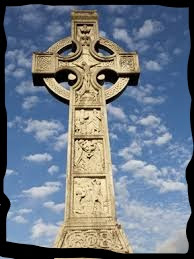27 March 1174 AD: Gilla Mic Liac, the Archbishop of Armagh, died on this day the Wednesday after Easter. He was the first Archbishop of Armagh to be described as a Primaith [Primate] and he was granted - presumably by papal sanction - the right to wear the pallium garment reserved for the Pope and the archbishops, but the latter may not use it until on petition they have received the permission of the Holy See.
Gilla Mae Liac [Gelasius], son of Ruaidhri, successor of Patrick, archbishop and primate of Ard-Macha and of all Ireland, son of chastity, full of purity of heart and of peace, died piously after choice old age, on the 6th of the Kalends of April [March 27], the Wednesday after Easter, in the 87th year of his age, the 37th of his episcopacy. That noble man was sixteen years full honourably in the abbacy of Columcille in Daire[Derry] before [receiving] the succession of Patrick. [Armagh].
Annals of Ulster
Gelasius [Gilla Meic Liac mac Diarmata] was a reforming Archbishop who had been picked for the job by the great Saint Maol Maodhog [Malachy] himself to help bring the Church into line with the ecclesiastical Reform movement that was taking hold across western Europe. Before he gained the highest position in the Gaelic Church he was the Abbot of Derry for sixteen years. In 1152 he organised the Synods of Kells & Mellifont (County Meath) that reformed the Irish Church on Diocesan lines in common with general European practise for the further Reform of the Church.
A further synod at Clane co Kildare in 1162 was attended by 26 bishops and instituted the practise of riaghail agus soibheas ‘good rules and conduct’ that further emphasised the overrule of Armagh as the source and authority of all teaching on matters ecclesiastical throughout Ireland. His death notice in the Martyrology of Gorman was noted with the description - geam amhra ceann banba - a notable gem, Ireland’s Head.
Prevented by old age and infirmity according to Gerald of Wales [Giraldus Cambrenis] from attending the Synod of Cashel in 1172, he subsequently confirmed its statutes in Dublin. Again according to Giraldus, the ‘common people’ thought of Giolla mic Liag [who by then allegedly depended on a white cow for sustenance] as a saint.
A Dictionary of Irish Saints
Padraig O Riain
'Gilla meic Liac's concerns for matters academic and spiritual were almost certainly matched by exigencies relating to the physical settlement at Armagh. While the only explicit reference to him in connection with building projects is the notice in 1145 of his construction of a lime kiln between the ecclesiastical site and Emain Macha, it was certainly the case that on three occasions during his episcopate Armagh was extensively damaged by fire and required reconstruction. This happened in 1137 (the year of his appointment), in 1164, and again two years later when, alone of the churches within the enclosure, the abbey of Saints Paul and Peter survived the conflagration. Armagh had long enjoyed the patronage of the Cenél nÉogain kings, and Gilla meic Liac could apparently count on the support of the high-king Muirchertach Mac Lochlainn. Muirchertach intervened in 1152, when Gilla meic Liac was physically attacked and wounded by supporters of the king of Airgialla, Donnchad Ua Cerbaill (qv), and had the latter deposed for a time.'
Dictionary of Irish Biography
Dictionary of Irish Biography | Dictionary of Irish Biography (dib.ie)


No comments:
Post a Comment